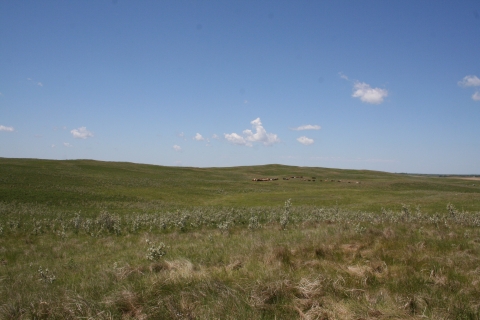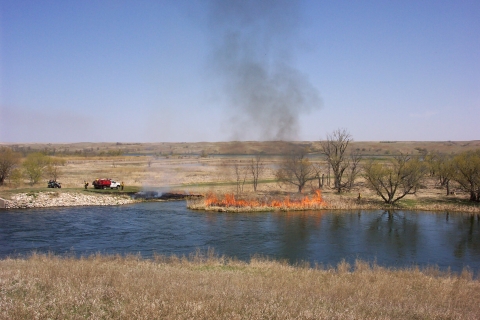What We Do
Wildlife conservation is at the heart of the National Wildlife Refuge System. It drives everything on U.S. Fish and Wildlife Service lands and waters managed within the Refuge System, from the purposes for which a national wildlife refuge national wildlife refuge
A national wildlife refuge is typically a contiguous area of land and water managed by the U.S. Fish and Wildlife Service for the conservation and, where appropriate, restoration of fish, wildlife and plant resources and their habitats for the benefit of present and future generations of Americans.
Learn more about national wildlife refuge is established to the recreational activities offered to the resource management tools used. Using conservation best practices, the Refuge System manages Service lands and waters to help ensure the survival of native wildlife species.
Refuges deploy a host of scientifically sound management tools to address biological challenges. These tools span active water management to wilderness character monitoring, all aimed at ensuring a balanced conservation approach to benefit both wildlife and people. Grassland management in the Wetland Management District includes rotational grazing, rotational haying, prescribed burning, and farming. A combination of the above management tools as well as spraying chemicals and using biological agents are used to control noxious weeds and other exotic species. Haying, grazing, and farming are accomplished cooperatively with approximately 50 private landowners each year.
Management strategies vary depending upon the habitat type, but the main goal for all habitats is to restore native prairie and to create temporally and spatially dynamic habitat conditions that will attract most breeding bird species and other vertebrate fauna characteristic of the mid-1800s era.
Management and Conservation
Haying
Haying is used to restore and maintain plant communities in the seasonally flooded meadows of the Souris River floodplain. These meadows attract grassland and wetland dependent bird species and other wildlife. Haying or mowing in the meadows sets back woody tree encroachment (mainly willows) and opens up the cattail edge around oxbows and wetlands.
Local cooperators can participate in a hay lottery every 4 years where hay units are assigned using a lottery system. Cooperators are responsible for the terms of the haying contract, which includes the management of noxious weeds through haying/mowing and chemical application. If you are interested in more information about our haying program, please contact us.
Grazing
One strategy used to restore native vegetation includes using a combination of grazing and prescribed fire. An ideal management sequence over 5 years might be BGGGR, where B = burn, G = graze, and R = rest. Grazing is primarily used during May through August or September, via a rotational approach with many relatively small grazing cells per unit and short grazing periods per cell. Stocking rates are adjusted to facilitate re-grazing of smooth brome plants at least once within a grazing period and livestock are moved to the next cell before native plants are re-grazed.
Local cooperators are given permits to graze specific units. If you would like more information about our grazing program or are interested in becoming a cooperator, please contact us.
View the grazing Cooperative Agricultural Agreement application.
Learn more about local and national haying and grazing opportunities.
Invasive Species
A combination of chemical, mechanical, and biological treatments are used to help control invasive species invasive species
An invasive species is any plant or animal that has spread or been introduced into a new area where they are, or could, cause harm to the environment, economy, or human, animal, or plant health. Their unwelcome presence can destroy ecosystems and cost millions of dollars.
Learn more about invasive species . Chemical treatments vary depending on target species and habitat type. Mechanical treatments include haying, grazing, and prescribed fire. Flea beetles are used for the biological control of leafy spurge. Leafy spurge, Canada thistle, absinth wormwood, and yellow toadflax are the main invasive species of concern in the J. Clark Salyer Wetland Management District Complex.
Prescribed Fire
North America’s grassland biome is the continent’s most endangered major ecosystem. The decline in extent and quality of North American prairies coincides with decreasing populations of many animal species that depend on them and is among the most challenging conservation issues of this century. In states and provinces of the northern prairie region, for example, native prairie has declined 30% to 99% due mainly to conversion for agriculture. Roughly 222,000 acres of native mixed-grass and tallgrass prairie are managed by the U.S. Fish and Wildlife Service in North Dakota and South Dakota. These areas range from small isolated 40 acre grasslands surrounded by cropland to large contiguous areas like J. Clark Salyer National Wildlife Refuge.
Prairies in the northern Great Plains evolved with interacting grazing (by bison, elk, antelope, small mammals, and insects) and fire disturbances (started by lightning and Native Americans). These events, along with drought, shaped grassland plant and animal communities. Woodland and forest, for example, were relatively uncommon before homesteading of North Dakotas vast grasslands. Before this European settlement of North Dakota, fires were common during all months of the year, re-occurring every 5–10 years in our area – this kept grassland mostly free from trees. These natural disturbances ended by the early-1900s, however, when bison were extirpated and most prairie fires were suppressed.
Today, prescribed fire and prescribed grazing by cattle are used by habitat managers to mimic or recreate natural events by bison and Native Americans that occurred before 1900. Annually, about 25,000-50,000 acres of grassland are periodically burned on refuge lands in the Dakotas and eastern Montana. Fire is used primarily to maintain or improve habitat for wildlife, restore native vegetation, and reduce dead vegetation.
Our Services
To provide the widest variety of quality wetland habitat for hundreds of thousands of migratory birds, Refuge staff manage water levels to maintain everything from wet soils to deep water conditions. This encourages growth of nutritious plants and other organisms and helps prevent cattails from over-growing the marshes.
Historically, the natural combination of wildfire and bison grazing maintained the grasslands in this area. Today, Refuge staff use a combination of haying, grazing, mowing, prescribed burning, spraying, and biological agents to control noxious weeds and prevent the invasion of grasslands by shrubs.
In addition, some areas of the Refuge that were farmed prior to Refuge establishment are being restored back to grasslands. The restoration process begins by farming these areas again for several years. Farming helps eliminate noxious weeds, reconditions the soil, and provides temporary food for wildlife. Eventually, grasses are re-established on the land.
Permits
The U.S. Fish and Wildlife Service issues permits under various wildlife law and treaties at a number of offices throughout the country. Permits enable the public to engage in legitimate wildlife-related activities that would otherwise be prohibited by law. Service permit programs ensure that such activities are carried out in a manner that safeguards wildlife. Additionally, some permits promote conservation efforts by authorizing scientific research, generating data, or allowing wildlife management and rehabilitation activates to go forward.
Law Enforcement
U.S. Fish and Wildlife Service law enforcement officers have a wide variety of duties and responsibilities. Officers help visitors understand and obey wildlife protection laws. They work closely with state and local government offices to enforce federal, state, and refuge hunting regulations that protect migratory birds and other game species from illegal take and preserve legitimate hunting opportunities. Some other duties include patrolling closed areas or Wilderness areas, maintaining relationships with neighboring landowners, maintaining refuge boundaries, and participating in public events related to refuge issues.
If you witness or suspect a wildlife violation, please report it to the:
North Dakota RAP Hotline: 1-800-472-2121 or J. Clark Salyer NWR: 1-701-768-2548
Laws and Regulations
Please observe the following regulations to protect natural resources and to help ensure your visit will be safe and enjoyable.
- Vehicles are allowed only on designated roads, parking areas, and on the ice for ice fishing.
- Vehicle access to ice is limited to ice that is accessible from a right-of-way or designated road.
- Vehicles must be licensed in accordance with State laws and regulations.
- Motorized boats are allowed for wildlife-dependent activities. Boats that must be launched from a trailer are limited to waters that are accessible from a right-of-way or designated road.
- Collection of mature wild fruits, berries, seeds, above-ground portions of asparagus, mushrooms, and rhubarb for personal, daily, non-commercial use is allowed.
- Commercial activities are not allowed unless authorized by a special use permit issued by the WMD manager. Prohibited Activities The following activities are prohibited on WPAs:
- Overnight camping
- Fires
- Target and recreational shooting
- Riding or using horses for any purpose
- Dog training (personal or professional)
- Removing or disturbing property, including artifacts
- Removing natural objects or destroying plants, excluding the gathering of dead plant materials for on-site blind construction
- Littering, including leaving trash, spent shotgun shells, or debris
- Discarding of animal carcasses Hunting Regulations Unless otherwise noted, hunting is allowed in accordance with State regulations.
Firearms
Persons possessing, transporting, or carrying firearms on National Wildlife Refuge System lands must comply with all provisions of State and local law. Persons may only use (discharge) firearms in accordance with refuge regulations (50 CFR 27.42 and specific refuge regulations in 50 CFR Part 32).
Firearms may only be fired on the waterfowl production area waterfowl production area
Waterfowl production areas are small natural wetlands and grasslands within the National Wildlife Refuge System that provide breeding, resting and nesting habitat for millions of waterfowl, shorebirds, grassland birds and other wildlife. Virtually all waterfowl production areas are in the Prairie Pothole Region states of Iowa, Minnesota, Montana, North Dakota and South Dakota.
Learn more about waterfowl production area in conjunction with a legal hunt for which the hunter is licensed.
Ammunition Small game hunters using shotguns are required to use and possess only non-toxic shot.
Equipment
Big Game Hunting Equipment and Removal Portable tree stands, portable ground blinds, and game cameras may be used for big game hunting from August 20 to January 31. Equipment not removed by January 31 will be considered abandoned property and subject to removal and confiscation by the U.S. Fish and Wildlife Service.
Equipment left unattended must have an identification tag that includes the owner’s name, address, and telephone number; or a unique identification number issued by the North Dakota Game and Fish Department. The identification tag must be readable from the ground.
The use of nails, wire, screws, or bolts to attach a stand or steps to a tree is prohibited.
With the exception of the big game hunting equipment listed previously, all personal property must be removed at the end of each day.
Dogs
The use of dogs is encouraged for hunting upland game birds and waterfowl. Dogs are allowed for other activities only if the dog is confined to a vehicle, boat, fish house, or is on a leash controlled by the handler.
Baiting
The distribution of bait and hunting over bait is prohibited.
Fishing Regulations
Unless otherwise noted, fishing is allowed in accordance with State regulations. Fish Houses Fish houses may be used for ice fishing in accordance with State regulations. Fish houses may not be left unattended in uplands or in parking areas.
Equipment Removal
Boats, motor vehicles, fishing equipment, and other personal property (excluding fish houses) must be removed at the end of each day.
Trapping Regulations
Trapping is allowed in accordance with Federal and State regulations.





